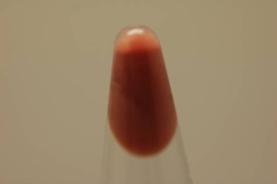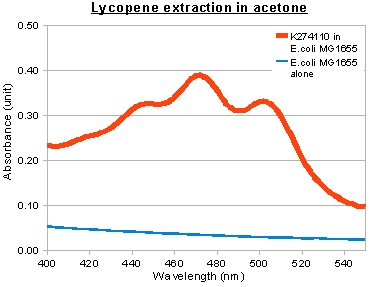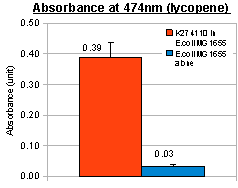Team:Cambridge/Project/CA03
From 2009.igem.org
Categories :
Project :
-
Overview
Sensitivity Tuner
--- Characterisation
--- Modelling
Colour Generators
--- Carotenoids (Orange/Red)
--- Melanin (Brown)
--- Violacein (Purple/Green)
The Future
Safety
Notebook :
Team Logistics :
Carotenoids
TESTING AND CHARACTERISATION
In vivo expression of our devices in E.coli MG1655
Our preliminary research indicated that carotenoids production in E.coli TOP10 was very weak. We decided to use another strain, E.coli MG1655, for in vivo expression of our devices. The amount of carotenoids produced became visibly higher. Generally, the colour became visible after incubation for about 12 hours.
Lycopene-producing device (constitutive)

| 
|
| E.coli MG1655 transformed with K274110 and grown on agar plate overnight. | Cell pellet of E.coli MG1655 transformed with K274210 (from 20mL LB culture at 37°C for 24 hours). |
β -carotene-producing device (constitutive)

| 
|
| E.coli MG1655 transformed with K274210 and grown on agar plate overnight. | Cell pellet of E.coli MG1655 transformed with K274220 (from 20mL LB culture at 37°C for 24 hours). |
Quantitative measurement of pigment production
In addition to visual inspection of coloured colonies, we hope to quantitatively measure the amount of lycopene or β-carotene produced by our devices. We grew transformed E.coli MG1655 in LB culture at 37°C for 24 hours and collected cell pellet by centrifugation. Acetone was added to the cell pellet and warmed at 50°C for 10 minutes, allowing carotenoids (lycopene or β-carotene) in the cells to dissolve. The acetone extracts were then put into MicroPlate Reader for a full photospectrum scan (wavelengths between 300nm and 800nm). The absorbance curves showed peaks characteristics of the respective carotenoids: at wavelength 474nm for lycopene, and 456nm for β-carotene. In the case of β-carotene, we used pure β-carotene of known amount as the standard reference and included it in the graph below.
Lycopene-producing device (constitutive)
 "
"

